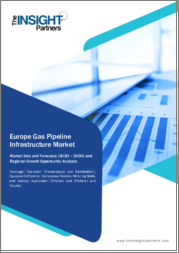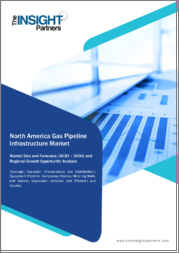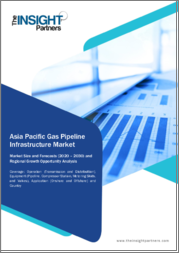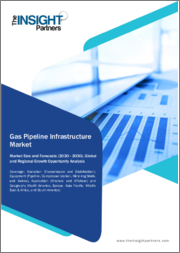
|
시장보고서
상품코드
1562424
유럽의 가스 파이프라인 인프라 시장 예측(-2030년) : 지역별 분석 - 사업별, 설비별, 용도별Europe Gas Pipeline Infrastructure Market Forecast to 2030 - Regional Analysis - by Operation (Transmission and Distribution), Equipment (Pipeline, Compressor Station, Metering Skids, and Others), and Application (Onshore and Offshore) |
||||||
유럽의 가스 파이프라인 인프라 시장은 2022년 9조 7,155억 8,000만 달러에서 2030년 11조 4,803억 9,000만 달러로 성장할 것으로 예상되며, 2022-2030년 CAGR은 2.1%를 기록할 것으로 추정됩니다.
재생에너지와의 통합이 유럽의 가스 파이프라인 인프라 시장을 견인
재생에너지와의 통합은 천연가스 파이프라인을 활용하여 태양광 및 풍력발전과 같은 재생에너지의 간헐적인 특성을 지원하는 것을 포함합니다. 이 통합은 파이프라인 사업자가 재생에너지 발전 사업자와 협력하여 재생에너지 발전을 보완하는 인프라에 투자할 수 있는 기회를 설명합니다. 예를 들어, 가스 화력 발전소는 재생에너지 출력이 낮은 기간 동안 백업 및 전력망 안정성을 제공하여 화석 연료에 대한 의존도와 탄소 배출을 줄일 수 있습니다. 또한, 전기에서 가스로의 전환과 같은 기술의 발전으로 잉여 재생에너지를 수소와 합성 천연가스로 변환하여 나중에 사용하기 위해 파이프라인에 저장할 수 있습니다. 천연가스 파이프라인을 재생에너지와 통합함으로써 기업은 탈탄소화 노력에 기여하고, 에너지 안보를 강화하며, 보다 지속가능한 에너지 시스템으로의 전환을 지원할 수 있습니다.
유럽의 가스 파이프라인 인프라 시장 개요
러시아, 독일, 프랑스, 스페인은 유럽의 가스 파이프라인 인프라 시장의 성장을 주도하는 주요 국가 중 하나입니다. 순 탄소 배출량 제로 및 청정에너지 목표에 부합하는 정부 정책과 지침은 가스 파이프라인 네트워크를 포함한 지속가능한 인프라에 대한 수요를 창출하고 있습니다. 유럽연합(EU)에서는 2022년 전력 부문의 이산화탄소 배출 비율이 크게 증가할 것으로 예상됩니다. 2015년 프랑스 파리에서 열린 유엔기후변화협약 당사국총회(COP21)에서 196개국이 참여한 파리협정에 따라 각국 정부는 순배출량 제로와 친환경 에너지 정책을 수립하고 있습니다. 그린에너지 정책을 수립하고 있습니다. 전력 믹스와 산업 부문에서 저탄소 배출 에너지 자원의 비중 확대는 이 지역 가스 파이프라인 인프라 시장의 주요 촉진요인입니다. 신규 파이프라인 인프라 개발 및 기존 가스 파이프라인의 용량 증가는 예측 기간 동안 유럽의 가스 파이프라인 인프라 시장의 성장을 촉진할 것으로 보입니다. 독일은 2022년 말까지 국내 광산 지역의 가스 자원 부족으로 인해 가스 생산량 증가세가 둔화될 것으로 예상됩니다. 독일은 미국, 이탈리아, 영국, 노르웨이 등 다양한 국가로부터의 수입에 크게 의존하고 있습니다. 국내 생산량은 가스 소비량의 6%에 불과해 에너지 수요의 약 70%를 수입하고 있으며, 2023년 독일과 이탈리아 정부는 가스 파이프라인 건설에 합의했습니다. 제안된 파이프라인은 3,300km 길이의 프로젝트로 트랜스 오스트리아 가스 라이팅, 수남, 바이에른 네츠, 독일 가스 커넥트 오스트리아 등 유럽 4개 송전 시스템 사업자가 참여할 예정입니다. 이처럼 새로운 파이프라인의 개발과 기존 가스 네트워크의 유지보수는 예측 기간 동안 독일의 가스 파이프라인 인프라 개발을 촉진할 것으로 예상됩니다.
유럽의 가스 파이프라인 인프라 시장 수익 및 2030년까지의 예측(10억 달러)
유럽의 가스 파이프라인 인프라 시장 세분화
유럽의 가스 파이프라인 인프라 시장은 사업, 설비, 용도, 국가별로 구분됩니다.
사업에 따라 유럽의 가스 파이프라인 인프라 시장은 송전과 배전으로 양분되며, 2022년 유럽의 가스 파이프라인 인프라 시장에서 배전 부문이 큰 비중을 차지했습니다.
장비 측면에서 유럽의 가스 파이프라인 인프라 시장은 파이프라인, 압축기 스테이션, 계량 스키드, 밸브로 분류됩니다. 파이프라인 부문은 2022년 유럽의 가스 파이프라인 인프라 시장에서 가장 큰 점유율을 차지했습니다.
용도별로 유럽의 가스 파이프라인 인프라 시장은 육상과 해상으로 나뉩니다. 육상 부문은 2022년 유럽의 가스 파이프라인 인프라 시장에서 더 큰 비중을 차지했습니다.
국가별로 유럽의 가스 파이프라인 인프라 시장은 독일, 프랑스, 이탈리아, 스페인, 러시아, 영국, 기타 유럽으로 구분됩니다. 기타 유럽이 2022년 유럽의 가스 파이프라인 인프라 시장을 장악할 것으로 예상됩니다.
Enbridge Inc, Berkshire Hathaway Inc, Kinder Morgan Inc, Beltps, Enagas SA, Saipem SpA 등은 유럽의 가스 파이프라인 인프라 시장에서 활동하는 주요 기업들입니다.
목차
제1장 소개
제2장 주요 요약
- 주요 인사이트
- 시장 매력
제3장 조사 방법
- 조사 범위
- 2차 조사
- 1차 조사
제4장 가스 파이프라인 인프라 시장 상황
- 소개
- 생태계 분석
- 발전
- 송전
- 배급
- 최종사용자
제5장 유럽의 가스 파이프라인 인프라 시장 : 주요 산업 역학
- 시장 성장 촉진요인
- 천연가스 수요 증가
- 장거리의 비용 효율
- 시장 성장 억제요인
- 태양광이나 풍력에 의한 재생에너지 발전에의 급속한 확대와 투자
- 시장 기회
- 재생에너지와의 통합
- 시장 동향
- 오프쇼어 가스 산업의 발전
- 성장 촉진요인과 저해요인의 영향
제6장 가스 파이프라인 인프라 시장 : 유럽 시장 분석
- 가스 파이프라인 인프라 시장 매출(2020-2030년)
- 가스 파이프라인 인프라 시장 예측과 분석
제7장 유럽의 가스 파이프라인 인프라 시장 분석 - 사업
- 소개
- 가스 파이프라인 인프라 시장 : 사업별(2022년, 2030년)
- 송전
- 송전 시장, 매출과 2030년까지 예측
- 배전
- 배전 시장, 매출과 2030년까지 예측
제8장 유럽의 가스 파이프라인 인프라 시장 분석 : 설비
- 소개
- 가스 파이프라인 인프라 시장 : 설비별(2022년, 2030년)
- 파이프라인
- 파이프라인 개요
- 파이프라인 시장, 매출과 2030년까지 예측
- 밸브
- 밸브 개요
- 밸브 시장, 매출과 2030년까지 예측
- 컴프레서 스테이션
- 컴프레서 스테이션 개요
- 컴프레서 스테이션 시장, 매출과 2030년까지 예측
- 계량 스키드
- 계량 스키드 시장, 매출과 2030년까지 예측
제9장 유럽의 가스 파이프라인 인프라 시장 분석 : 용도
- 소개
- 가스 파이프라인 인프라 시장 : 용도별(2022년, 2030년)
- 온쇼어
- 온쇼어
- 온쇼어 시장 매출과 2030년까지 예측
- 오프쇼어
- 오프쇼어 개요
- 오프쇼어 시장, 매출과 2030년까지 예측
제10장 유럽의 가스 파이프라인 인프라 시장 : 국가별 분석
- 유럽 시장 개요
- 독일
- 프랑스
- 이탈리아
- 스페인
- 러시아
- 영국
- 기타 유럽
제11장 업계 상황
- 소개
- 시장 이니셔티브
- 인수합병
제12장 기업 개요
- Enbridge Inc
- Berkshire Hathaway Inc
- Kinder Morgan Inc
- Beltps
- Enagas SA
- Saipem SpA
제13장 부록
ksm 24.10.25The Europe gas pipeline infrastructure market is expected to grow from US$ 9,715.58 billion in 2022 to US$ 11,480.39 billion by 2030. It is estimated to record a CAGR of 2.1% from 2022 to 2030.
Integration with Renewable Energy Drives Europe Gas Pipeline Infrastructure Market
Integration with renewable energy involves leveraging natural gas pipelines to support the intermittent nature of renewable sources such as solar and wind power. This integration offers opportunities for pipeline operators to collaborate with renewable energy developers and invest in infrastructure that complements renewable energy generation. For example, gas-fired power plants can provide backup and grid stability during periods of low renewable energy output, reducing reliance on fossil fuels and carbon emissions. Additionally, advancements in technologies like power-to-gas allow excess renewable energy to be converted into hydrogen or synthetic natural gas, which can be stored in pipelines for later use. By integrating natural gas pipelines with renewable energy sources, companies can contribute to decarbonization efforts, enhance energy security, and support the transition to a more sustainable energy system.
Europe Gas Pipeline Infrastructure Market Overview
Russia, Germany, France, and Spain are some of the major countries aiding to the overall growth of the gas pipeline infrastructure market in Europe. The government policies and mandates in line with the net zero carbon emission and clean energy targets are creating the demand for sustainable infrastructure, including gas pipeline networks. In the European Union, the carbon dioxide ratio in the power sector intensified substantially in 2022. A few countries resumed operations at coal-driven power plants, while outages at nuclear plants and low hydropower production fueled the dependability of natural gas. In line with the Paris Agreement, which involved 196 participants at the UN Climate Change Conference (COP21) in Paris, France, in 2015-the government is establishing net zero emission and green energy policies. The growing share of low-carbon emission energy resources in the power mix and the industrial sector are major driving factors for the gas pipeline infrastructure market in the region. The development of new pipeline infrastructure and the advancement of the capacity of existing gas pipelines are also likely to fuel the growth of the gas pipeline infrastructure market in Europe over the forecast period. Germany experienced slow growth in gas production until the end of 2022 due to the scarcity of gas resources across the country's mining areas. The country relies majorly on imports from different countries, such as the US, Italy, the UK, and Norway. It imports approximately 70% of its energy requirements as its domestic production caters to only ~6% of its gas consumption. In 2023, the governments of Germany and Italy collaborated to form a projected gas pipeline. The proposed pipeline is a 3,300 km project and is anticipated to incorporate four European transmission system operators, including Trans Austria Gasleitung, Snam, Bayernets, and Gas Connect Austria in Germany. Thus, the development of the new pipeline and maintenance of the existing gas network is anticipated to boost the development of gas pipeline infrastructure in Germany over the forecast period.
Europe Gas Pipeline Infrastructure Market Revenue and Forecast to 2030 (US$ Billion)
Europe Gas Pipeline Infrastructure Market Segmentation
The Europe gas pipeline infrastructure market is segmented into operation, equipment, application, and country.
Based on operation, the Europe gas pipeline infrastructure market is bifurcated into transmission and distribution. The distribution segment held a larger share of Europe gas pipeline infrastructure market in 2022.
In terms of equipment, the Europe gas pipeline infrastructure market is categorized into pipeline, compressor station, metering skids, and valves. The pipeline segment held the largest share of Europe gas pipeline infrastructure market in 2022.
Based on application, the Europe gas pipeline infrastructure market is bifurcated into onshore and offshore. The onshore segment held a larger share of Europe gas pipeline infrastructure market in 2022.
Based on country, the Europe gas pipeline infrastructure market is segmented into Germany, France, Italy, Spain, Russia, the UK, and the Rest of Europe. The Rest of Europe dominated the Europe gas pipeline infrastructure market in 2022.
Enbridge Inc, Berkshire Hathaway Inc, Kinder Morgan Inc, Beltps, Enagas SA, and Saipem SpA are some of the leading companies operating in the Europe gas pipeline infrastructure market.
Table Of Contents
1. Introduction
- 1.1 The Insight Partners Research Report Guidance
- 1.2 Market Segmentation
2. Executive Summary
- 2.1 Key Insights
- 2.2 Market Attractiveness
3. Research Methodology
- 3.1 Coverage
- 3.2 Secondary Research
- 3.3 Primary Research
4. Gas Pipeline Infrastructure Market Landscape
- 4.1 Overview
- 4.2 Ecosystem Analysis
- 4.2.1 Production
- 4.2.2 Transmission
- 4.2.3 Distribution
- 4.2.4 End User
5. Europe Gas Pipeline Infrastructure Market - Key Industry Dynamics
- 5.1 Market Drivers
- 5.1.1 Rise in Demand for Natural Gas
- 5.1.2 Cost-Effectiveness Over Long Distances
- 5.2 Market Restraints
- 5.2.1 Rapid Expansion or Investment towards Renewable Power Generation from Solar and Wind
- 5.3 Market Opportunities
- 5.3.1 Integration with Renewable Energy
- 5.4 Market Trends
- 5.4.1 Growing Developments in the Offshore Gas Industry
- 5.5 Impact of Drivers and Restraints:
6. Gas Pipeline Infrastructure Market - Europe Market Analysis
- 6.1 Gas Pipeline Infrastructure Market Revenue (US$ Billion), 2020 - 2030
- 6.2 Gas Pipeline Infrastructure Market Forecast and Analysis
7. Europe Gas Pipeline Infrastructure Market Analysis - Operation
- 7.1 Overview
- 7.2 Gas Pipeline Infrastructure Market, By Operation (2022 and 2030)
- 7.3 Transmission
- 7.3.1 Overview
- 7.3.2 Transmission Market, Revenue and Forecast to 2030 (US$ Billion)
- 7.4 Distribution
- 7.4.1 Overview
- 7.4.2 Distribution Market, Revenue and Forecast to 2030 (US$ Billion)
8. Europe Gas Pipeline Infrastructure Market Analysis - Equipment
- 8.1 Overview
- 8.2 Gas Pipeline Infrastructure Market, By Equipment (2022 and 2030)
- 8.3 Pipeline
- 8.3.1 Overview
- 8.3.2 Pipeline Market, Revenue and Forecast to 2030 (US$ Billion)
- 8.4 Valves
- 8.4.1 Overview
- 8.4.2 Valves Market, Revenue and Forecast to 2030 (US$ Billion)
- 8.5 Compressor station
- 8.5.1 Overview
- 8.5.2 Compressor station Market, Revenue and Forecast to 2030 (US$ Billion)
- 8.6 Metering skids
- 8.6.1 Overview
- 8.6.2 Metering skids Market, Revenue and Forecast to 2030 (US$ Billion)
9. Europe Gas Pipeline Infrastructure Market Analysis - Application
- 9.1 Overview
- 9.2 Gas Pipeline Infrastructure Market, By Application (2022 and 2030)
- 9.3 Onshore
- 9.3.1 Overview
- 9.3.2 Onshore Market, Revenue and Forecast to 2030 (US$ Billion)
- 9.4 Offshore
- 9.4.1 Overview
- 9.4.2 Offshore Market, Revenue and Forecast to 2030 (US$ Billion)
10. Europe Gas Pipeline Infrastructure Market - Country Analysis
- 10.1 Europe Market Overview
- 10.1.1 Europe Gas Pipeline Infrastructure Market, By Key Country - Revenue 2022 (US$ Bn)
- 10.1.2 Europe Gas Pipeline Infrastructure Market Revenue and Forecasts and Analysis - By Country
- 10.1.2.1 Europe Gas Pipeline Infrastructure Market Revenue and Forecasts and Analysis - By Country
- 10.1.2.2 Germany Gas Pipeline Infrastructure Market Revenue and Forecasts to 2030 (US$ Bn)
- 10.1.2.2.1 Germany Gas Pipeline Infrastructure Market Breakdown by Operation
- 10.1.2.2.2 Germany Gas Pipeline Infrastructure Market Breakdown by Equipment
- 10.1.2.2.3 Germany Gas Pipeline Infrastructure Market Breakdown by Application
- 10.1.2.3 France Gas Pipeline Infrastructure Market Revenue and Forecasts to 2030 (US$ Bn)
- 10.1.2.3.1 France Gas Pipeline Infrastructure Market Breakdown by Operation
- 10.1.2.3.2 France Gas Pipeline Infrastructure Market Breakdown by Equipment
- 10.1.2.3.3 France Gas Pipeline Infrastructure Market Breakdown by Application
- 10.1.2.4 Italy Gas Pipeline Infrastructure Market Revenue and Forecasts to 2030 (US$ Bn)
- 10.1.2.4.1 Italy Gas Pipeline Infrastructure Market Breakdown by Operation
- 10.1.2.4.2 Italy Gas Pipeline Infrastructure Market Breakdown by Equipment
- 10.1.2.4.3 Italy Gas Pipeline Infrastructure Market Breakdown by Application
- 10.1.2.5 Spain Gas Pipeline Infrastructure Market Revenue and Forecasts to 2030 (US$ Bn)
- 10.1.2.5.1 Spain Gas Pipeline Infrastructure Market Breakdown by Operation
- 10.1.2.5.2 Spain Gas Pipeline Infrastructure Market Breakdown by Equipment
- 10.1.2.5.3 Spain Gas Pipeline Infrastructure Market Breakdown by Application
- 10.1.2.6 Russia Gas Pipeline Infrastructure Market Revenue and Forecasts to 2030 (US$ Bn)
- 10.1.2.6.1 Russia Gas Pipeline Infrastructure Market Breakdown by Operation
- 10.1.2.6.2 Russia Gas Pipeline Infrastructure Market Breakdown by Equipment
- 10.1.2.6.3 Russia Gas Pipeline Infrastructure Market Breakdown by Application
- 10.1.2.7 UK Gas Pipeline Infrastructure Market Revenue and Forecasts to 2030 (US$ Bn)
- 10.1.2.7.1 UK Gas Pipeline Infrastructure Market Breakdown by Operation
- 10.1.2.7.2 UK Gas Pipeline Infrastructure Market Breakdown by Equipment
- 10.1.2.7.3 UK Gas Pipeline Infrastructure Market Breakdown by Application
- 10.1.2.8 Rest of Europe Gas Pipeline Infrastructure Market Revenue and Forecasts to 2030 (US$ Bn)
- 10.1.2.8.1 Rest of Europe Gas Pipeline Infrastructure Market Breakdown by Operation
- 10.1.2.8.2 Rest of Europe Gas Pipeline Infrastructure Market Breakdown by Equipment
- 10.1.2.8.3 Rest of Europe Gas Pipeline Infrastructure Market Breakdown by Application
11. Industry Landscape
- 11.1 Overview
- 11.2 Market Initiative
- 11.3 Mergers & Acquisitions
12. Company Profiles
- 12.1 Enbridge Inc
- 12.1.1 Key Facts
- 12.1.2 Business Description
- 12.1.3 Products and Services
- 12.1.4 Financial Overview
- 12.1.5 SWOT Analysis
- 12.1.6 Key Developments
- 12.2 Berkshire Hathaway Inc
- 12.2.1 Key Facts
- 12.2.2 Business Description
- 12.2.3 Products and Services
- 12.2.4 Financial Overview
- 12.2.5 SWOT Analysis
- 12.2.6 Key Developments
- 12.3 Kinder Morgan Inc
- 12.3.1 Key Facts
- 12.3.2 Business Description
- 12.3.3 Products and Services
- 12.3.4 Financial Overview
- 12.3.5 SWOT Analysis
- 12.3.6 Key Developments
- 12.4 Beltps
- 12.4.1 Key Facts
- 12.4.2 Business Description
- 12.4.3 Products and Services
- 12.4.4 Financial Overview
- 12.4.5 SWOT Analysis
- 12.4.6 Key Developments
- 12.5 Enagas SA
- 12.5.1 Key Facts
- 12.5.2 Business Description
- 12.5.3 Products and Services
- 12.5.4 Financial Overview
- 12.5.5 SWOT Analysis
- 12.5.6 Key Developments
- 12.6 Saipem SpA
- 12.6.1 Key Facts
- 12.6.2 Business Description
- 12.6.3 Products and Services
- 12.6.4 Financial Overview
- 12.6.5 SWOT Analysis
- 12.6.6 Key Developments
13. Appendix
- 13.1 About the Insight Partners
- 13.2 Word Index



















